Content is from Kirkbride et al. 2006Kirkbride et al. 2006:
Kirkbride JH, Jr, Gunn CR, and Dallwitz MJ. 2006. Family guide for fruits and seeds, vers. 1.0. Accessed September 2020-January 2022. URL: https://nt.ars-grin.gov/seedsfruits/keys/frsdfam/index.cfm ., without modification.
Updates are forthcoming.
Fruits: Pistil(s) compound; 1; 1-pistillate; with carpels united. Fruit pericarpium; simple; capsulecapsule:
a dry, dehiscent fruit derived from a compound ovary ; septicidalsepticidal:
; septicidalsepticidal:
type of capsular dehiscence, opening longitudinally by separating between the septa of adjacent carpels
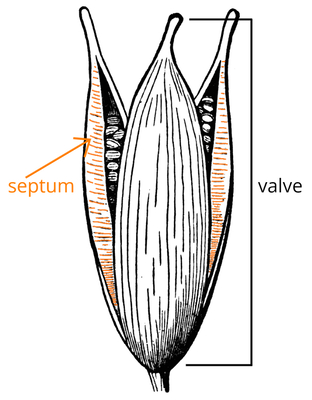 capsulecapsule:
capsulecapsule:
a dry, dehiscent fruit derived from a compound ovary and septifragalseptifragal:
and septifragalseptifragal:
type of capsular dehiscence, splitting through the exterior wall suture(s) but not the septum(-a), the valves of the wall then separating from the septum(-a) and the locules thus opened directly to the outside
capsulecapsule:
a dry, dehiscent fruit derived from a compound ovary ; capsulecapsule:
; capsulecapsule:
a dry, dehiscent fruit derived from a compound ovary not inflated; capsulecapsule:
not inflated; capsulecapsule:
a dry, dehiscent fruit derived from a compound ovary without operculumoperculum:
without operculumoperculum:
a dehiscent cap (or lid) of a seed or fruit that opens during germination or dehiscence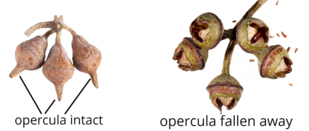 ; with persistent central column; valves diverging from top of central column (resembling umbrella ribs); not within accessory organ(s); more than 1 but less than 10-seeded; 2-seeded; from 1–5 cm long; 1.7–2 cm long; with carpels united; with carpels separating at maturity; with carpels not radiating at maturity; with carpels remaining connected at stylestyle:
; with persistent central column; valves diverging from top of central column (resembling umbrella ribs); not within accessory organ(s); more than 1 but less than 10-seeded; 2-seeded; from 1–5 cm long; 1.7–2 cm long; with carpels united; with carpels separating at maturity; with carpels not radiating at maturity; with carpels remaining connected at stylestyle:
in a flower, the narrow and elongated part of the pistil between the stigma and the ovary; sometimes persisting in fruit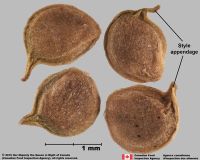 ; without sterilesterile:
; without sterilesterile:
lacking male and/or female reproductive parts; also, not producing fruit or seed
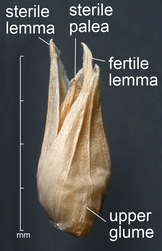 carpels; apexapex:
carpels; apexapex:
the point farthest from the point of attachment, or the "tip" of an organ not beaked; dehiscentdehiscent:
not beaked; dehiscentdehiscent:
(v. dehisce) splitting open at maturity to release contents (of a fruit)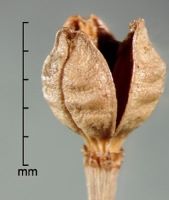 . Dehiscentdehiscent:
. Dehiscentdehiscent:
(v. dehisce) splitting open at maturity to release contents (of a fruit) unit seed(s). Dehiscentdehiscent:
unit seed(s). Dehiscentdehiscent:
(v. dehisce) splitting open at maturity to release contents (of a fruit) and shedding seeds; without replumreplum:
and shedding seeds; without replumreplum:
the rim, formed by the persistent placentas, and connected by a false septum in Brassicaceae fruits. The fruit valves are attached to this rim and separate from it in dehiscent fruits.
. Epicarpepicarp:
outer layer of fruit wall or pericarp, if divided into layers; note here used synonymously with exocarp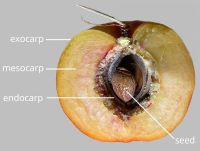 durable; not glabrousglabrous:
durable; not glabrousglabrous:
without hairs
(with hairs); hairs medium length (assumed); hairs not glandularglandular:
surface relief—covered with small, raised secretory glands, regular or irregularly shaped, translucent or opaque, and maybe distinctly colored ; without armature; without wing(s); without apicalapical:
; without armature; without wing(s); without apicalapical:
at or pertaining to the end of the seed or fruit distal from its point of attachment (i.e., base)
respiratory hole. Endocarpendocarp:
the inner layer of the pericarp, if divided into layers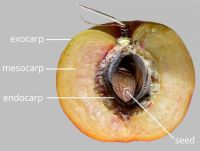 present; not separating from exocarpexocarp:
present; not separating from exocarpexocarp:
outer layer of fruit wall or pericarp, if divided into layers; note here used synonymously with epicarp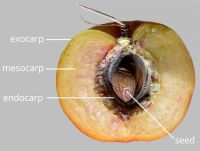 ; thin; not splitting into 1-seeded pyrenes; smooth; without operculumoperculum:
; thin; not splitting into 1-seeded pyrenes; smooth; without operculumoperculum:
a dehiscent cap (or lid) of a seed or fruit that opens during germination or dehiscence ; without secretory cavities; without mechanism for seedling escape; without grooves; without longitudinallongitudinal:
; without secretory cavities; without mechanism for seedling escape; without grooves; without longitudinallongitudinal:
of or relating to length or the lengthwise dimension
ridges. Funiculusfuniculus:
(alt. funicle) stalk connecting the ovule (later seed) to the ovary (later fruit) placenta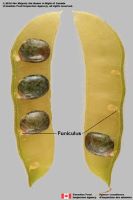 short; short without seed bearing hookswith hooks:
short; short without seed bearing hookswith hooks:
bristles or spines with curved or backwards pointing tips, or with secondary bristles along their length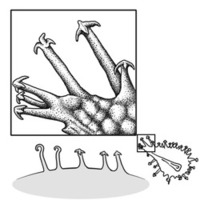 (retinacula); not persisting in fruit after seed shed.
(retinacula); not persisting in fruit after seed shed.
Seeds: Arilaril:
(broad sense) appendicular structure that wholly or partly envelops a seed and is produced from or a modification of the funicle, raphe, or outer integument; usually fleshy or pulpy, sometimes spongy or tufted-capillate, often brightly colored absent. Seed larger than minute; ellipsoidellipsoid:
absent. Seed larger than minute; ellipsoidellipsoid:
3D shape—elliptic
; not bowl shaped; not nutlike; without winglike beakbeak:
a usually firm, terminal appendage, sometimes tapered ; without caudatecaudate:
; without caudatecaudate:
tapering to a long, tail-like appendage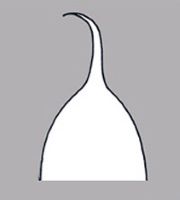 appendage(s); without canavanine. Sarcotestasarcotesta:
appendage(s); without canavanine. Sarcotestasarcotesta:
pulpy or fleshy outer layer of the seed coat, simulates aril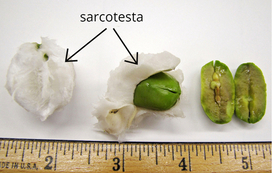 absent. Testatesta:
absent. Testatesta:
seed coat
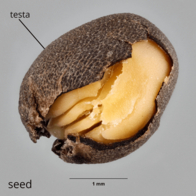 present; without fleshy or leatheryleathery:
present; without fleshy or leatheryleathery:
texture—moderately thick, tough, and very pliable
layer over hard layer; without glands; without bristles; without wings; without collar; without operculumoperculum:
a dehiscent cap (or lid) of a seed or fruit that opens during germination or dehiscence ; colored; monochrome; brown (all shades). Embryo well developed.
; colored; monochrome; brown (all shades). Embryo well developed.
Link (1993): Fruit septicidal-septifragal rostrate capsulecapsule:
a dry, dehiscent fruit derived from a compound ovary packed with long-shaggy hairs becoming detached from base to apexapex:
packed with long-shaggy hairs becoming detached from base to apexapex:
the point farthest from the point of attachment, or the "tip" of an organ , viz., valves remaining attached at apexapex:
, viz., valves remaining attached at apexapex:
the point farthest from the point of attachment, or the "tip" of an organ . See drawing. Fruit 1.7–2 cm long.
. See drawing. Fruit 1.7–2 cm long.
Literature specific to this family: Link, D.A. 1993. 45. Dirachmaceae. In: M. Thulin, ed., Flora of Somalia, vol 1, pp. 191–192. Royal Botanic Gardens, Kew; Thulin, M., B. Bremer, J. Richardson, J. Niklasson, M.F. Fay, & M.W. Chase. 1998. Family relationships of the enigmatic rosid genera Barbeya and Dirachma from the Hornhorn:
a straight or curved, slenderly conic or conoidal protrusion, resembling an animal horn
of Africa region. Pl. Syst. Evol. 213:103–119; Link, D.A. 1991. Dirachma somalensis D.A. Link sp. nov. A new species of a remarkable and highly endangered monogeneric family. Bull. Jard. Bot. Natl. Belg. 61:3–13.
General references: Mabberley, D.J. 1987. The plant-book, 706 p. Cambridge University Press, Cambridge.